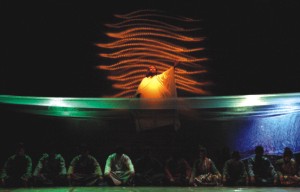|
Theatre
Life In Motion
Ershad Kamol
 |
(Top) The buffalo crosses the Swameswari River. (Bottom) A tragic scene at the end of the play. |
Death is inevitable: every creature must taste bitter death in the world. When his adopted daughter Anwita was diagnosed with cancer, the legendary playwright Selim Al Deen wrote Dhaboman. A believer in animism, the late Selim Al Deen, theatre icon of the postcolonial Bangla literature, has allegorically presented how death silently stalks life in Dhaboman. As a playwright and theoretician, Selim Al Deen developed a unique form based on the tradition of the indigenous performing art forms of Bengal, what he labeled as 'Dwoitadwoitobad'. According to Al Deen's Dwoitadwoitobad, theatre is an incorporation of all art forms, a concept reflected in Dhaboman.
The storyline of the play is simple: the birth of a buffalo calf named Sohrab, which the owner Nahbat treats like his own son but ultimately sacrifices when Sohrab becomes an adult buffalo. But the mastery of Al Deen's construction and language gives this simple storyline an epic quality.
Like the heroes of world classics such as Sohrab in the Persian epic the " Shahnameh" and Achilles in the Greek epic the "Iliad", the buffalo Sohrab grows up in Nahbat's home in Dhaboman. Nahbat teaches the buffalo the art of war, subsequently the buffalo becomes the champion at the annual buffalo fight in the area which is located by the Swameshwari River. It is a place in the greater Mymensingh area where Bangalis have been living side by side with the Mandi people.
The beauty of Al Deen's narrative in Dhaboman lies in the spontaneous appearance of traditional cultural heritage, myths and rituals of both communities. Some human characters such as Nahabat Ali and Munindra Marak have been developed as believers of animism.
 |
| Artistes of Dhaka Treatre perform in the play. |
Presenting such a play on stage is no doubt, a challenging task. As a debutant director eminent actor Shiful Yousuf's approach is experimental. She has used elements of rituals and traditional art forms in her directorial composition. Her presentation of ashon bandana (a traditional style of beginning a performance in indigenous performing art form) is not like the traditional one.
She has used the fast rhythm of drums and the actors on the proscenium stage in three groups to make circular movements in slow tempo with distinctive stances, which is very similar to the traditional Japanese puppet theatre called Bunraku, which also narrates a ballad. The similarity may be an unconscious emulation, but even the actors during the ashon bandona in Dhaboman wear long attire similar to the Japanese costumes, which is very unusual to our custom.
 |
Portrayal of a dream scene. |
Yousuf's compositions contain many journeys where the actors in stances move. The physical strength of the artistes of the troupe required for dance-music-drama form may have been overestimated. The director must keep in mind the resources and limitations of a troupe before composition. It's quite natural that the actors will have some limitations of performing in scenes portraying so many movements unless they are properly trained. But, most of the actors who have performed in Dhaboman have no proper training on dance, nor are they traditional artistes who develop their unique style through gruelling hours of practice. As a result, actions have properly worked only in the scenes where the actors got room to prove their potential of acting. Following the earlier productions of Dhaka Theatre, a leading troupe of Dhaka, Shimul Yousuf could have relied more on narratives instead of experimenting on so many forms.
The major drawback of her directorial composition is that the turning points of the play have not been well developed. Scenes such as Nahabat's physically challenged son, Eshak's 'dreams' that he will be cured if the buffalo is sacrificed and the mighty buffalo Sohrab's slaughtering could be done with more attention. In fact, the play seems to end rather abruptly.
Seasoned actor Shahiduzzaman Selim in the role of Nahabat Ali, Asaduzzaman Aman as Munindra Marak and Sajjad Ahmed Rajib as Eshak performed well.
Dhaboman, the 33rd production of Dhaka Theatre, was premiered on March 20 at the National Theatre Stage.
Copyright
(R) thedailystar.net 2009 |
